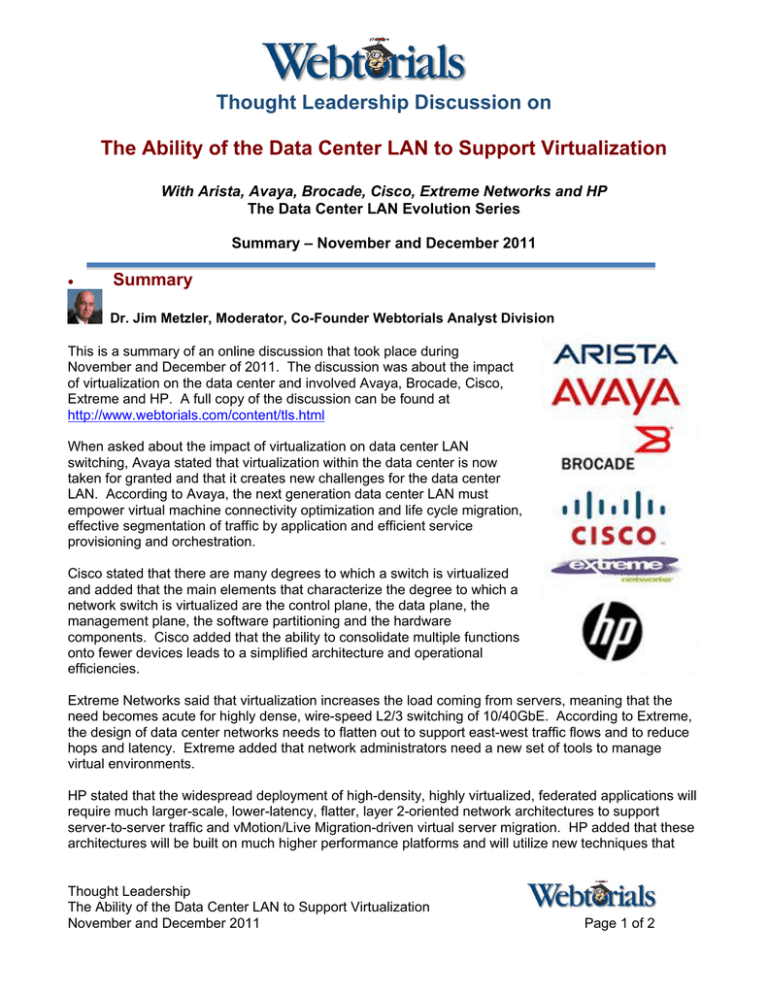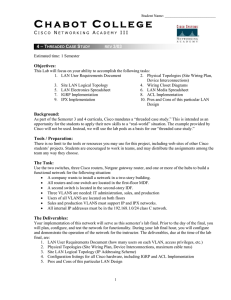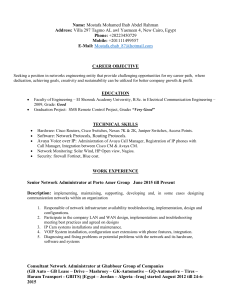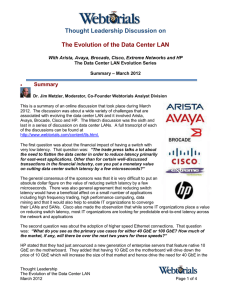Thought Leadership Discussion on Summary
advertisement

Thought Leadership Discussion on The Ability of the Data Center LAN to Support Virtualization With Arista, Avaya, Brocade, Cisco, Extreme Networks and HP The Data Center LAN Evolution Series Summary – November and December 2011 • Summary Dr. Jim Metzler, Moderator, Co-Founder Webtorials Analyst Division This is a summary of an online discussion that took place during November and December of 2011. The discussion was about the impact of virtualization on the data center and involved Avaya, Brocade, Cisco, Extreme and HP. A full copy of the discussion can be found at http://www.webtorials.com/content/tls.html When asked about the impact of virtualization on data center LAN switching, Avaya stated that virtualization within the data center is now taken for granted and that it creates new challenges for the data center LAN. According to Avaya, the next generation data center LAN must empower virtual machine connectivity optimization and life cycle migration, effective segmentation of traffic by application and efficient service provisioning and orchestration. Cisco stated that there are many degrees to which a switch is virtualized and added that the main elements that characterize the degree to which a network switch is virtualized are the control plane, the data plane, the management plane, the software partitioning and the hardware components. Cisco added that the ability to consolidate multiple functions onto fewer devices leads to a simplified architecture and operational efficiencies. Extreme Networks said that virtualization increases the load coming from servers, meaning that the need becomes acute for highly dense, wire-speed L2/3 switching of 10/40GbE. According to Extreme, the design of data center networks needs to flatten out to support east-west traffic flows and to reduce hops and latency. Extreme added that network administrators need a new set of tools to manage virtual environments. HP stated that the widespread deployment of high-density, highly virtualized, federated applications will require much larger-scale, lower-latency, flatter, layer 2-oriented network architectures to support server-to-server traffic and vMotion/Live Migration-driven virtual server migration. HP added that these architectures will be built on much higher performance platforms and will utilize new techniques that Thought Leadership The Ability of the Data Center LAN to Support Virtualization November and December 2011 Page 1 of 2 eliminate the need for protocols such as the spanning tree protocol and the virtual router redundancy protocol. When asked to identify the functionality that needs to be in a data center LAN switch in order to support the dynamic movement of virtual machines between physical servers, HP stated what is needed is the: • Automatic discovery of virtual machines, virtual switches and their relationships with the physical network • VM and virtual switch resource management, including the creation of virtual switches and port groups • Virtual/Physical topology views and status indicators for networks, workloads and virtual switches • Automatic reconfiguration of network policies that move with VM/workloads as they move within or across the data center Cisco said that the features that are required to support mobility include: • Security and QoS per VM • Data protection per VM • Scalability /performance management per VM • Trending and capacity planning for each VM Cisco added that in order to enable VM migration, the network should have the ability to support VM motion without impacting performance. Brocade stated that data center LAN switches must be VM-aware, which to Brocade means that the switches must: • Place no physical barriers in the way of VM migration • Be aware of VM locations and consistently apply network policies • Not require manual intervention when a VM moves to a new physical machine • Remove the overhead of switching traffic from the hypervisor • Support heterogeneous server virtualization in the same network Avaya stated that the question of what should be in the data center LAN switch is a minor question and the more pertinent issue is the policy control associated with the VM in general and with the migration of the VM in particular. Avaya added that the network access control characteristics associated with a VM in one location need to follow it to the new location. According to Avaya, that capability requires a policy tracking function and the ability to know whether or not the edge device in the new location is capable of applying equivalent policies. Avaya added that this type of orchestration requires a higher level of functionality then just the internals of an individual switch. The sponsors were asked to identify forms of virtualization, other than server virtualization, that are likely to have a big impact on the data center LAN. They were also asked to describe the impact of those forms of virtualization and what has to be in the data center LAN to support them. Cisco stated it is important to understand the composite entities that make up a virtual data center, and that this includes data, storage, processors, the network, and a super-control plane. Cisco added that an important technique to consider when building an end-to-end virtualized data center is the ability to partition a single physical device into multiple logical devices. *** Thought Leadership The Ability of the Data Center LAN to Support Virtualization November and December 2011 Page 2 of 2



